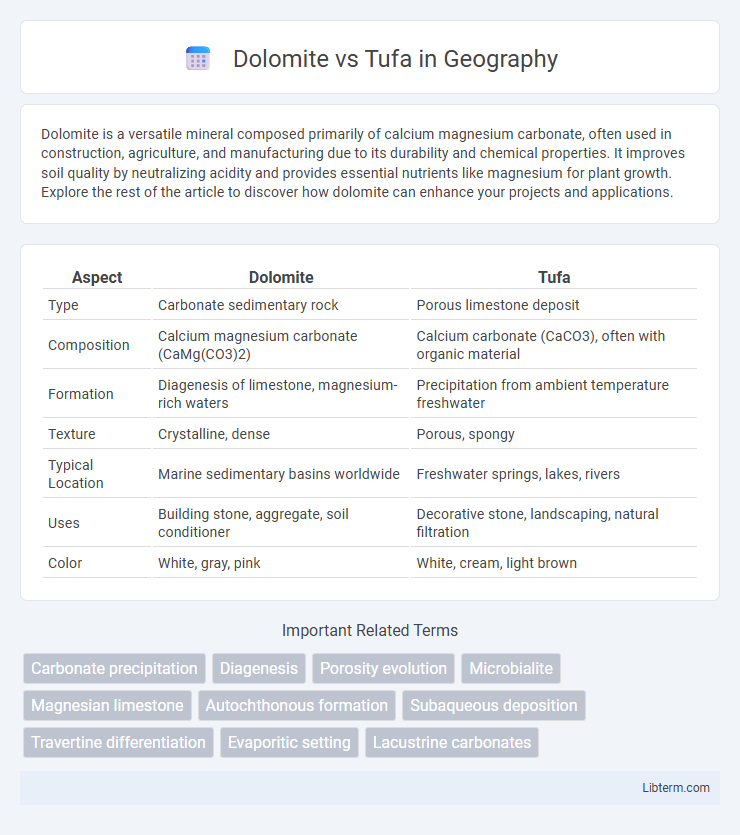Dolomite is a versatile mineral composed primarily of calcium magnesium carbonate, often used in construction, agriculture, and manufacturing due to its durability and chemical properties. It improves soil quality by neutralizing acidity and provides essential nutrients like magnesium for plant growth. Explore the rest of the article to discover how dolomite can enhance your projects and applications.
Table of Comparison
| Aspect | Dolomite | Tufa |
|---|---|---|
| Type | Carbonate sedimentary rock | Porous limestone deposit |
| Composition | Calcium magnesium carbonate (CaMg(CO3)2) | Calcium carbonate (CaCO3), often with organic material |
| Formation | Diagenesis of limestone, magnesium-rich waters | Precipitation from ambient temperature freshwater |
| Texture | Crystalline, dense | Porous, spongy |
| Typical Location | Marine sedimentary basins worldwide | Freshwater springs, lakes, rivers |
| Uses | Building stone, aggregate, soil conditioner | Decorative stone, landscaping, natural filtration |
| Color | White, gray, pink | White, cream, light brown |
Introduction: Understanding Dolomite and Tufa
Dolomite is a sedimentary carbonate rock composed primarily of the mineral dolomite, characterized by its calcium magnesium carbonate composition and often used in construction and agriculture. Tufa forms through the precipitation of carbonate minerals from ambient temperature water bodies, creating porous, soft rock commonly found near springs and waterfalls. Both materials differ in formation processes, mineral composition, and typical environmental settings, influencing their practical applications and geological significance.
Geological Formation of Dolomite
Dolomite forms through a diagenetic process where magnesium-rich fluids replace calcium in limestone, creating a distinct carbonate mineral composed of calcium magnesium carbonate. This geological transformation typically occurs in shallow marine environments or evaporitic settings, where chemical conditions favor magnesium incorporation. In contrast, tufa is a porous limestone deposit formed by the rapid precipitation of calcium carbonate from freshwater springs or streams, lacking the magnesium substitution characteristic of dolomite.
Geological Formation of Tufa
Tufa forms through the rapid precipitation of calcium carbonate from ambient temperature water bodies, often near limestone-rich springs or lakes, resulting in porous, lightweight deposits. Its geological formation involves biogenic influences, where algae, bacteria, and plants promote carbonate precipitation by altering water chemistry. In contrast, dolomite originates through diagenetic alteration of limestone, involving magnesium-rich fluids that replace calcium with magnesium in the mineral lattice, creating a denser, crystalline rock.
Physical Properties: Dolomite vs Tufa
Dolomite is a dense, crystalline sedimentary rock composed primarily of calcium magnesium carbonate, exhibiting high hardness and durability with a Mohs hardness of around 3.5 to 4. Tufa, a porous, soft limestone formed by rapid precipitation of calcium carbonate in freshwater, has lower density and hardness, typically ranging from 1 to 3 on the Mohs scale. The physical contrast between dolomite's compact texture and tufa's lightweight, porous structure influences their uses in construction and landscaping.
Chemical Composition Comparison
Dolomite is primarily composed of calcium magnesium carbonate (CaMg(CO3)2), containing roughly equal parts of calcium and magnesium ions, while tufa consists mainly of calcium carbonate (CaCO3) with minor impurities depending on its formation environment. The key chemical difference lies in dolomite's magnesium content, which substitutes part of the calcium ions found in tufa, resulting in a denser, more crystalline structure. This compositional contrast impacts their solubility, reactivity, and application in industries such as construction and environmental remediation.
Key Differences in Appearance
Dolomite typically appears as crystalline, white, gray, or pinkish mineral with a glassy luster and often forms in rhombohedral crystals, exhibiting a smooth and dense texture. Tufa, in contrast, is a porous, spongy rock primarily composed of calcium carbonate, generally off-white or beige, and often shows a rough, porous surface due to its formation from precipitated carbonate minerals in water. The key appearance difference lies in dolomite's smooth, crystalline structure versus tufa's irregular, porous, and lightweight texture.
Common Locations and Occurrences
Dolomite commonly forms in sedimentary basins such as ancient marine environments and shallow subsurface settings, often found in places like the Midwestern United States and parts of Europe. Tufa occurs mainly at freshwater springs, lakes, and waterfalls, frequently located in regions with high carbonate precipitation such as the western United States and the Mediterranean basin. Both minerals are calcium carbonate-based but differ in their typical geological settings, with dolomite favoring marine sedimentary rocks and tufa forming in evaporative freshwater environments.
Applications and Uses in Industry
Dolomite is widely used in the steel industry as a flux to remove impurities during iron and steel production, and it serves as a key component in cement manufacturing due to its high calcium and magnesium content. Tufa, a porous form of limestone, finds applications in water treatment systems for filtration and as a lightweight building material in landscaping and construction, valued for its thermal insulation properties. Both minerals are important in agriculture: dolomite acts as a soil conditioner to neutralize acidity and supply essential nutrients, while tufa enhances soil aeration and water retention.
Environmental Significance of Dolomite and Tufa
Dolomite plays a vital role in carbon sequestration by absorbing CO2 from the atmosphere, which helps mitigate climate change and improve soil pH in agricultural lands. Tufa forms in freshwater environments through rapid precipitation of calcium carbonate, creating unique habitats that support diverse aquatic ecosystems and act as natural water filters. Both dolomite and tufa contribute to ecosystem stability but differ in formation processes and environmental functions essential for biodiversity and geochemical cycles.
Conclusion: Choosing Between Dolomite and Tufa
Dolomite offers superior durability and higher calcium and magnesium content, making it ideal for construction and soil amendment applications where strength and mineral balance are crucial. Tufa, characterized by its porous and lightweight structure, suits landscaping and filtration uses where aeration and water flow are prioritized. Selecting between dolomite and tufa depends on specific project needs, balancing factors like density, mineral composition, and intended environmental benefits.
Dolomite Infographic

 libterm.com
libterm.com